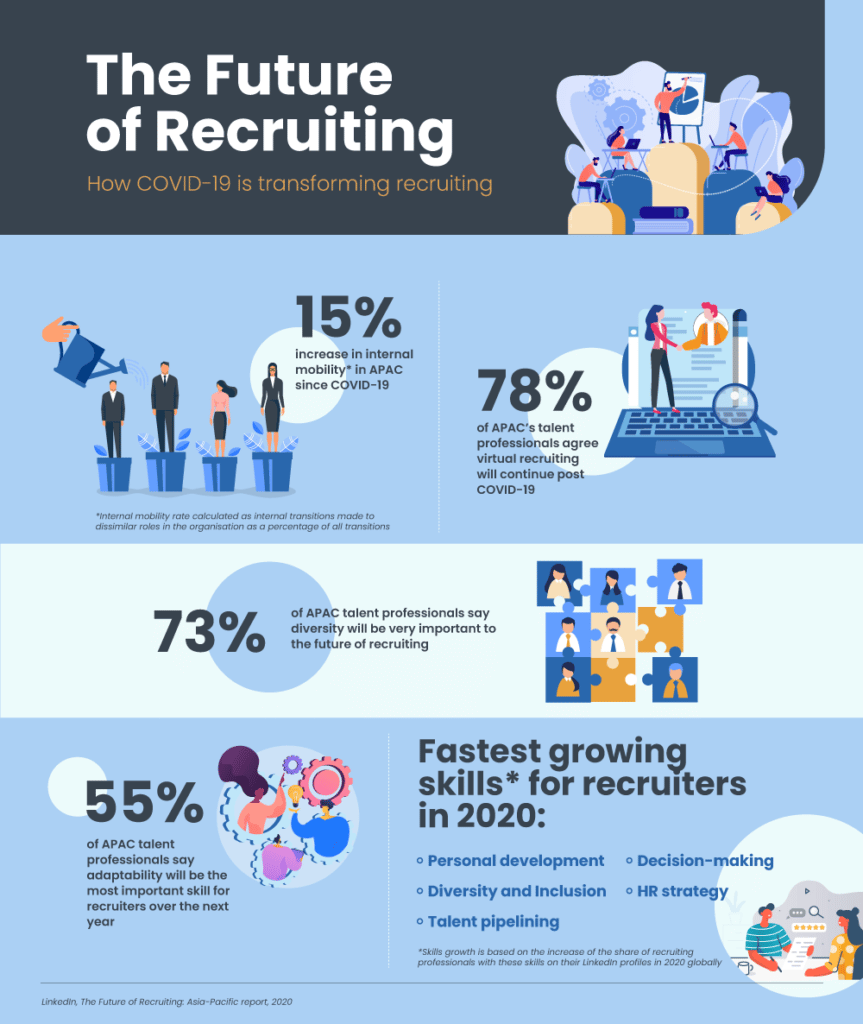Time-to-hire is an important metric for the hiring team. It measures the time passing from between an applicant was first contacted by your company and the time that they accept a job offer.
Although it may seem that TTH is pretty straightforward, it also indicates your recruiting team’s hiring efficiency. Is it or is it not?
For example, is your HR team displaying a long lag time between the two timeline points? If they do, it might be the time to look into improving your hiring strategies.
As if you’re an HR manager, you need to keep tabs on these metrics to detect any inefficiency that occurs in any of the stages in the hiring process. If there is, your team can devise and implement measures that will address and eliminate those hiring barriers and delays.
Thus, you can boost productivity of the HR team, while ensuring you’re not keeping a top talent waiting much longer. Or else, they’re more likely to accept another offer – especially young professionals receive multiple offers at the same time.
Why measure time-to-hire?
Measuring the TTH, you can identify if there are weak spots in your recruitment and selection process. And in this case, you can create improvements that will shorten the time between your first contact with the candidate and the time you offer the job.

Time-to-Hire vs. Time-to-Fill
Before we go on discussing more about time to hire, let’s talk about the difference between it and time-to-fill. These two terms are often interchanged because they’re synonymous. They’re also known as one-and-the-same that can be measured separately to help your HR team come up with different metrics. Both of them can improve the efficiency in your organization’s hiring process. Check this out.
- Time-to-hire: It measures the total time that the candidate applies until the time they receive and accept a job offer.
- Time-to-fill: It measures the amount of time that vacant positions remain unfilled.
However, aside from the time-to-hire, some hiring teams overlook the candidate slate. It’s a list of qualified candidates that you want to wait until you have enough before you start interviewing prospective candidates.
Having a candidate slate is better than interviewing the first one or two qualified candidates that apply. Why? A candidate slate gives you a clear comparison and overview of ideal candidates – and this can help you make a good hiring decision.
What’s the average time-to-hire?
There is no set average for all companies because different factors can influence this, including specific functions and industry and supply of talent. For example, it can take longer to fill a position in an industry with a scarce talent supply when compared to a position with a lot of supply.
Also, many of the studies that have been undertaken emphasize more on the time-to-fill than the time-to-hire, in which the average TTF is 36 days, while 24 days on the average time for screening applicants and accepting a job offer, according to an SHRM report.
How to improve time-to-hire
Looking into your current hiring process and improving it can benefit both the applicants and your HR team. One of the best ways to do this is to improve your time-to-hire. Here’s how.
Collect the right data
This will reduce the time it takes the time to hire and fill a vacant position. You’ll need data to help you detect any inefficiency in the process, and then make improvements that will eventually streamline it.
- How much time does it take recruitment to fill a position?
- What is the number of calendar days it takes from the final selection to the job offer?
- How much time does it take before a candidate move from one stage to the next? (E.g. application to the phone interview)
- What’s the standard TTH in your industry and what’s your average time to hire?
- How many poor applications do you receive?
Collect and analyze this data to figure out the weak spots in your hiring process. What are the most alarming numbers and how can you improve them?
For example, it takes applicants three days to send their CV/resume, and then it takes your hiring manager one week to respond. There is a delay in the manual tasks that you might want to automate.
A few of the repetitive HR tasks that you might want to automate include screening applicants and analyzing their resumes to checking their pre-employment assessment tests, and so on. You can also automate interview scheduling with chosen candidates.
Automating HR tasks with tools, such as Hiring Nest’s suite of recruitment and hiring features, will free up time for your hiring manager and the rest of the time and give them opportunities for important activities.

Structure your hiring process
A poor structure, without even saying, will take it longer for your hiring team to fill a role and worse can make you end up starting over again when you have to fill the same position in the next year or so.
Do you have a process in place? What does it look like, especially the candidate journey? What are the application steps involved and for each how much time is needed?
Streamlining your recruitment and selection process can help you find qualified candidates and save you money in the end. For example, having a structured process can prevent future damages due to a bad hiring decision.
The typical steps involved in the recruiting process are planning, attracting candidates, selecting candidates, and offering the job. For example, before posting a job advertisement, you will need a job opening to be approved as a part of a hiring plan. Your team will discuss the recruiting budget, create the job description, and then gather your hiring team, according to the same source.
Build your talent pipeline in advance
Talent pipelines can give you organization a consistent and steady access to qualified candidates. It is one of the most effective ways of speeding up the hiring process and making faster hires.
Your talent pipeline is a candidate pool consists of qualified candidates who are ready to fill a position when the need arises. It is like putting them on a speed dial, not requiring you to advertise your job or having to wait for applicants to apply.
In this case, you also don’t need to vet the candidates. What’s left for you is to contact those people in your pipeline to let them know about the vacant role.
A few questions
- What are the roles you often need to fill?
- What are your requirements to fill these positions?
- Who are the talents that look suitable for them?
- Where can you find those candidates to fill these roles?
- What strategies to use?
- Who will be managing your talent pipeline?
Once you’ve identified the answers to these questions, think of ways to stay connected with these ideal candidates. You might want to share personalized messaging or valuable content to them.
Staying in the minds of your talent pipeline
Consider adding a personal touch to reach out to them and discuss their career goals. You might also want to use a talent relationship management system to help your team identify when to reach out and follow up to your pipeline when you need to fill a relevant position.
By doing this, you can save your team’s time and your resources because you’re targeting suitable candidates, who are best suitable for your company culture and requirements. This will also eliminate the time to spend on interviewing candidates.
Launch a referral campaign! Ask employees to refer ideal candidates in their network. It will help you save time from sourcing from step 1. To keep employees interested in referring top talents into your organization, offer a referral bonus or incentive.
Make your office or workplace a desirable, harmonious place to work. To be successful in talent pipelining, you must show how you are attractive as an employer. You can also set up a careers page where to allow candidates to upload their resumes and have a continuous flow of applications – from which to find rare gems. Who knows?
Engage with top talents through events and ensure that you stay in touch with them through follow-up communication. If you’re speaking further to a candidate, communicate clear and defined steps to them.
For new applicants, you can keep in touch and take advantage of the timeliness through sending them an email that welcomes them and informs them about what they can expect from you.
But as said earlier, you must automate as many of the recruiting steps by using technology, like in the applicant screening and pre-assessment process.
Together with keeping a talent pipeline, you can improve your hiring efficiency through the use of technology to streamline many of the processed involved in hiring a talent.

Create a good careers page
There are certain things you can do to improve your time to hire, and one of those is to write a good job description.
A job description is your key to attracting the right candidates, so write a concise, clear, and accurate job description. And to make it more visible in search results, make your career page SEO-friendly.
Create one that is mobile-friendly, too. 45 percent of job seekers use their phone or mobile device in searching for jobs at least once a day, with 89 percent revealing their mobile device is important in job searching, according to GlassDoor.
Also, ensure that you’re showing candidates what it feels and looks like to work for you. What makes your company different? What is your company culture? What are your company values, goals and visions?
Your career page showcases your brand because it displays much of your personality and in short your organizational culture. For a good start, you might want to add rich media content, including photos of your team and employee videos.
However, ensure that you remain consistent in all the channels that your company uses to communicate and get in touch with potential candidates. Doing so will strengthen your brand.
In addition, your career page must make it easy for candidates to apply so that you will not lose good ones. By doing so, you’ll have an increased chance of inviting applicants to finish the process. Strategically place your apply now button and help candidates decide to continue and apply.
And once they’re done applying, keep them engaged throughout the application process using an applicant tracking system. It will help you manage their applications through technology. This system allows you to manage your application, including providing feedback to candidates.
It can analyze information and categorize your candidates based on your requirements, allowing you to hire top talents for your organization.
Utilize pre-employment assessment tools
Personality tests, cognitive ability assessments, and skill tests are valuable in finding the right candidates because they allow you to pick those with the suitability to work for you not just for their qualifications but also for your company culture – culture fit.
However, they can make the hiring process longer, which is why it might be helpful to use pre-assessment tools that will automate this process.
For example, such software can help your company with a job skills test that usually takes an average of 0.6 to 1.5 days or with a cognitive ability assessment that usually adds between 2.6 and 4.4 days to the hiring process on the average.
Using a screening solution, you can save up your people’s time, while allowing them to work on important things – like improving the time-to-hire.
But as while they’re saving you time and resources, pre-assessment tools use a systematic approach to ensure that the results are accurate. They can help you screen the applicants that fit your culture and suit your requirements. In short, these pre-assessment tools help with a smart screening that also eliminates too much reliance on resumes.
Use an applicant tracking system
An ATS will be with you every step of the way from the time you posted the job advertisement to sending you important alerts when applicants apply.
It can speed up the hiring process through increasing each phase’s efficiency. In this case, you don’t just save your people’s time but also reduces the chances that a good applicant drops off in any of the hiring stage because of the slow recruitment process.
An efficient ATS is one of the keys to streamline your hiring process and shorten the time-to-hire because it can improve every stage, such as applicant screening, interview scheduling, and building the talent pipeline.
A primary function of the ATS is to narrow down the applicant pool. It prevents overwhelming your hiring managers with tons of applications. The tool makes it easy for them to screen applicants and eliminate not qualified candidates.
That being said, it’s safe to conclude that the right applicant tracking system helps save time and money for your business. It can reduce the number of applicants quickly by determining only the top candidates. This is particularly helpful for companies that open different positions simultaneously in at least one department and want to reduce the recruiting time.
Use one-stop hiring platform
Instead of using separate tools in your recruiting department, you might also consider only one solution that can manage your entire hiring process.
This will prevent you from losing candidates if the different tools are not working well together. You can find solutions with multiple functionalities, an employee onboarding solution included.

Review and improve your job ad
You know so well that writing the job description is the sourcing stage’s first step. So by not making it compelling, concise, and clear, you might lose your chance of hiring your ideal candidates.
This can impact your time-to-hire because losing them makes the hiring process longer. To create an effective job post, use gender-neutral words or language to attract more candidates.
Review the job post and check if there are any internal acronyms and jargons. Remove them and other confusing terms that are not understood and recognized by a lot of applicants. Write for humans.
Don’t forget to include important details about your organization culture, instead of only discussing about what you do or what you business is about. Put more focus on your working environment and what kind of employer you are.
Is your offer competitive? If you’re including salaries, rewards, and benefits, compare them with other companies in the same industry within your areas. You might consider re-thinking of the amount especially for highly-qualified applicants with experience that might be attracted by other companies.
Automate interview scheduling and make it quick
With many companies conducting at least three interviews, time-to-hire may be longer. To reduce it, you might want to use an automated interview tools to speed up the scheduling and prevent any delays.
Using technology in this stage just like in the others can ensure that you will have a more efficient HR team and provide a better candidate experience.
Summing Up
Time-to-hire is an important hiring metric. Making it efficient and streamlined, you can improve the overall recruitment process, while also providing applicants with a smooth #candidatejourney. Look at your current recruitment process, determine areas where delays happen, and be ready to make the necessary improvements.

